The Role of Programmed Cell Death 1/Programmed Death Ligand 1 (PD-1/PD-L1) Axis in Sepsis-Induced Apoptosis
Abstract
1. Introduction
2. Materials and Methods
2.1. Study Design and Patient Characteristics
2.2. Evaluated Parameters
- CD4/CD8/CD3 (BDTritest, Cat. No. 342414);
- CD3/CD16 + CD56/CD45/CD19 (BD Multitest, Cat. No. 342416).
2.3. Statistical Analysis
3. Results
3.1. Population Analysis
3.2. Comparison of Variables for the Entire Amount of Patients
3.3. Comparison of Variables for the Sepsis and Septic Shock Groups
3.4. Comparison of Variables for the Survivor and Non-Survivor Groups
3.5. Comparison of Variables for the Survivor and Non-Survivor Groups
4. Discussion
5. Conclusions
Supplementary Materials
Author Contributions
Funding
Institutional Review Board Statement
Informed Consent Statement
Data Availability Statement
Conflicts of Interest
References
- Rudd, K.E.; Johnson, S.C.; Agesa, K.M.; Shackelford, K.A.; Tsoi, D.; Kievlan, D.R.; Colombara, D.V.; Ikuta, K.S.; Kissoon, N.; Finfer, S.; et al. Global, regional, and national sepsis incidence and mortality, 1990–2017: Analysis for the Global Burden of Disease Study. Lancet 2020, 395, 200–211. [Google Scholar] [CrossRef]
- Nedeva, C.; Menassa, J.; Puthalakath, H. Sepsis: Inflammation Is a Necessary Evil. Front. Cell Dev. Biol. 2019, 7, 108. [Google Scholar] [CrossRef]
- Pei, F.; Yao, R.Q.; Ren, C.; Bahrami, S.; Billiar, T.R.; Chaudry, I.H.; Chen, D.-C.; Chen, X.-L.; Cui, N.; Fang, X.-M.; et al. Expert consensus on the monitoring and treatment of sepsis-induced immunosuppression. Mil. Med. Res. 2022, 9, 74. [Google Scholar] [CrossRef]
- Singer, M.; Deutschman, C.S.; Seymour, C.W.; Shankar-Hari, M.; Annane, D.; Bauer, M.; Bellomo, R.; Bernard, G.R.; Chiche, J.-D.; Coopersmith, C.M.; et al. The Third International Consensus Definitions for Sepsis and Septic Shock (Sepsis-3). JAMA 2016, 315, 801–810. [Google Scholar] [CrossRef]
- Lu, X.; Yang, Y.M.; Lu, Y.Q. Immunosenescence: A Critical Factor Associated with Organ Injury After Sepsis. Front. Immunol. 2022, 13, 917293. [Google Scholar] [CrossRef]
- Lu, X.; Lu, Y.Q. Editorial: Immunosenescence after sepsis. Front. Immunol. 2023, 14, 1177148. [Google Scholar] [CrossRef] [PubMed] [PubMed Central]
- Monneret, G.; Gossez, M.; Venet, F. Sepsis and immunosenescence: Closely associated in a vicious circle. Aging Clin. Exp. Res. 2021, 33, 729–732. [Google Scholar] [CrossRef]
- Cecconi, M.; Evans, L.; Levy, M.; Rhodes, A. Sepsis and septic shock. Lancet 2018, 392, 75–87. [Google Scholar] [CrossRef]
- Van der Poll, T.; Shankar-Hari, M.; Wiersinga, W.J. The immunology of sepsis. Immunity 2021, 54, 2450–2464. [Google Scholar] [CrossRef]
- Rizvi, M.S.; Gallo De Moraes, A. New Decade, Old Debate: Blocking the Cytokine Pathways in Infection-Induced Cytokine Cascade. Crit. Care Explor. 2021, 3, e0364. [Google Scholar] [CrossRef]
- Gustave, C.A.; Gossez, M.; Demaret, J.; Rimmelé, T.; Lepape, A.; Malcus, C.; Poitevin-Later, F.; Jallades, L.; Textoris, J.; Monneret, G.; et al. Septic Shock Shapes B Cell Response toward an Exhausted-like/Immunoregulatory Profile in Patients. J. Immunol. 2018, 200, 2418–2425. [Google Scholar] [CrossRef]
- Das, U.N. Infection, Inflammation, and Immunity in Sepsis. Biomolecules 2023, 13, 1332. [Google Scholar] [CrossRef]
- Cicchese, J.M.; Evans, S.; Hult, C.; Joslyn, L.R.; Wessler, T.; Millar, J.A.; Marino, S.; Cilfone, N.A.; Mattila, J.T.; Linderman, J.J.; et al. Dynamic balance of pro- and anti-inflammatory signals controls disease and limits pathology. Immunol. Rev. 2018, 285, 147–167. [Google Scholar] [CrossRef]
- Oami, T.; Watanabe, E.; Hatano, M.; Sunahara, S.; Fujimura, L.; Sakamoto, A.; Ito, C.; Toshimori, K.; Oda, S. Suppression of T Cell Autophagy Results in Decreased Viability and Function of T Cells Through Accelerated Apoptosis in a Murine Sepsis Model. Crit. Care Med. 2017, 45, e77–e85. [Google Scholar] [CrossRef]
- Chen, J.; Wang, H.; Guo, R.; Li, H.; Cui, N. Early Expression of Functional Markers on CD4+ T Cells Predicts Outcomes in ICU Patients with Sepsis. Front. Immunol. 2022, 13, 938538. [Google Scholar] [CrossRef]
- Zhang, T.; Yu-Jing, L.; Ma, T. Role of regulation of PD-1 and PD-L1 expression in sepsis. Front. Immunol. 2023, 14, 1029438. [Google Scholar] [CrossRef]
- Zhong, S.; Yin, Y. Regulatory role of the programmed cell death 1 signaling pathway in sepsis induced immunosuppression. Front. Immunol. 2023, 14, 1183542. [Google Scholar] [CrossRef]
- Liu, D.; Huang, S.Y.; Sun, J.H.; Zhang, H.-C.; Cai, Q.-L.; Gao, C.; Li, L.; Cao, J.; Xu, F.; Zhou, Y.; et al. Sepsis-induced immunosuppression: Mechanisms, diagnosis and current treatment options. Mil. Med. Res. 2022, 9, 56. [Google Scholar] [CrossRef]
- Van den Berg, M.; van Beuningen, F.E.; Ter Maaten, J.C.; Bouma, H.R. Hospital-related costs of sepsis around the world: A systematic review exploring the economic burden of sepsis. J. Crit. Care 2022, 71, 154096. [Google Scholar] [CrossRef]
- Prest, J.; Nguyen, T.; Rajah, T.; Prest, A.B.; Sathananthan, M.; Jeganathan, N. Sepsis-Related Mortality Rates and Trends Based on Site of Infection. Crit. Care Explor. 2022, 4, e0775. [Google Scholar] [CrossRef]
- Klastrup, V.; Hvass, A.M.; Mackenhauer, J.; Fuursted, K.; Schønheyder, H.C.; Kirkegaard, H.; Network, C.S. Site of infection and mortality in patients with severe sepsis or septic shock. A cohort study of patients admitted to a Danish general intensive care unit. Infect. Dis. 2016, 48, 726–731. [Google Scholar] [CrossRef]
- Chen, Y.; Huang, J.; Xu, J.; Qiu, R.; Lin, T. Association between site of infection and mortality in patients with cancer with sepsis or septic shock: A retrospective cohort study. Exp. Ther. Med. 2022, 25, 33. [Google Scholar] [CrossRef]
- Francois, B.; Jeannet, R.; Daix, T.; Walton, A.H.; Shotwell, M.S.; Unsinger, J.; Monneret, G.; Rimmelé, T.; Blood, T.; Morre, M.; et al. Interleukin-7 restores lymphocytes in septic shock: The IRIS-7 randomized clinical trial. JCI Insight 2018, 3, e98960. [Google Scholar] [CrossRef]
- Nedeva, C. Inflammation and Cell Death of the Innate and Adaptive Immune System during Sepsis. Biomolecules 2021, 11, 1011. [Google Scholar] [CrossRef]
- Hai, P.D.; Viet Hoa, L.T. The Prognostic Accuracy Evaluation of mNUTRIC, APACHE II, SOFA, and SAPS 2 Scores for Mortality Prediction in Patients with Sepsis. Crit. Care Res. Pract. 2022, 2022, 4666594. [Google Scholar] [CrossRef]
- Bauer, M.; Gerlach, H.; Vogelmann, T.; Preissing, F.; Stiefel, J.; Adam, D. Mortality in sepsis and septic shock in Europe, North America and Australia between 2009 and 2019- results from a systematic review and meta-analysis. Crit. Care 2020, 24, 239. [Google Scholar] [CrossRef]
- Fuchs, P.A.; Czech, I.J.; Krzych, Ł.J. The Pros and Cons of the Prediction Game: The Never-ending Debate of Mortality in the Intensive Care Unit. Int. J. Environ. Res. Public Health 2019, 16, 3394. [Google Scholar] [CrossRef]
- Rubio, I.; Osuchowski, M.F.; Shankar-Hari, M.; Skirecki, T.; Winkler, M.S.; Lachmann, G.; La Rosée, P.; Monneret, G.; Venet, F.; Bauer, M.; et al. Current gaps in sepsis immunology: New opportunities for translational research. Lancet Infect. Dis. 2019, 19, e422–e436. [Google Scholar] [CrossRef]
- Wang, Y.; Dong, C.; Han, Y.; Gu, Z.; Sun, C. Immunosenescence, aging and successful aging. Front. Immunol. 2022, 13, 942796. [Google Scholar] [CrossRef]
- Misra, A.K.; Levy, M.M.; Ward, N.S. Biomarkers of Immunosuppression. Crit. Care Clin. 2020, 36, 167–176. [Google Scholar] [CrossRef]
- Torres, L.K.; Pickkers, P.; van der Poll, T. Sepsis-Induced Immunosuppression. Annu. Rev. Physiol. 2022, 84, 157–181. [Google Scholar] [CrossRef]
- Sari, M.I.; Ilyas, S. The Expression Levels and Concentrations of PD-1 and PD-L1 Proteins in Septic Patients: A Systematic Review [published correction appears in Diagnostics (Basel) 2023, 13, 1555]. Diagnostics 2022, 12, 2004. [Google Scholar] [CrossRef]
- Chen, R.; Zhou, L. PD-1 signaling pathway in sepsis: Does it have a future? Clin. Immunol. 2021, 229, 108742. [Google Scholar] [CrossRef]
- Ruan, W.S.; Feng, M.X.; Xu, J.; Xu, Y.-G.; Song, C.-Y.; Lin, L.-Y.; Li, L.; Lu, Y.-Q. Early Activation of Myeloid-Derived Suppressor Cells Participate in Sepsis-Induced Immune Suppression via PD-L1/PD-1 Axis. Front. Immunol. 2020, 11, 1299. [Google Scholar] [CrossRef]
- Qin, W.; Hu, L.; Zhang, X.; Jiang, S.; Li, J.; Zhang, Z.; Wang, X. The Diverse Function of PD-1/PD-L Pathway Beyond Cancer. Front. Immunol. 2019, 10, 2298. [Google Scholar] [CrossRef]
- Konstantinidou, M.; Zarganes-Tzitzikas, T.; Magiera-Mularz, K.; Holak, T.A.; Dömling, A. Immune Checkpoint PD-1/PD-L1: Is There Life Beyond Antibodies? Angew. Chem. Int. Ed. Engl. 2018, 57, 4840–4848. [Google Scholar] [CrossRef]
- Tang, Q.; Chen, Y.; Li, X.; Long, S.; Shi, Y.; Yu, Y.; Wu, W.; Han, L.; Wang, S. The role of PD-1/PD-L1 and application of immune-checkpoint inhibitors in human cancers. Front. Immunol. 2022, 13, 964442. [Google Scholar] [CrossRef]
- Nakamori, Y.; Park, E.J.; Shimaoka, M. Immune Deregulation in Sepsis and Septic Shock: Reversing Immune Paralysis by Targeting PD-1/PD-L1 Pathway. Front. Immunol. 2021, 11, 624279. [Google Scholar] [CrossRef]
- Shao, R.; Fang, Y.; Yu, H.; Zhao, L.; Jiang, Z.; Li, C.S. Monocyte programmed death ligand-1 expression after 3-4 days of sepsis is associated with risk stratification and mortality in septic patients: A prospective cohort study. Crit. Care 2016, 20, 124. [Google Scholar] [CrossRef]
- Wilson, J.K.; Zhao, Y.; Singer, M.; Spencer, J.; Shankar-Hari, M. Lymphocyte subset expression and serum concentrations of PD-1/PD-L1 in sepsis—Pilot study. Crit. Care 2018, 22, 95. [Google Scholar] [CrossRef]
- Yi, M.; Zheng, X.; Niu, M.; Zhu, S.; Ge, H.; Wu, K. Combination strategies with PD-1/PD-L1 blockade: Current advances and future directions. Mol. Cancer 2022, 21, 28. [Google Scholar] [CrossRef] [PubMed]
- Hu, Y.M.; Hsiung, Y.C.; Pai, M.H.; Yeh, S.L. Glutamine Administration in Early or Late Septic Phase Downregulates Lymphocyte PD-1/PD-L1 Expression and the Inflammatory Response in Mice with Polymicrobial Sepsis. JPEN J. Parenter. Enter. Nutr. 2018, 42, 538–549. [Google Scholar] [CrossRef] [PubMed]
- Patil, N.K.; Guo, Y.; Luan, L.; Sherwood, E.R. Targeting Immune Cell Checkpoints during Sepsis. Int. J. Mol. Sci. 2017, 18, 2413. [Google Scholar] [CrossRef] [PubMed]
- Budimir, N.; Thomas, G.D.; Dolina, J.S.; Salek-Ardakani, S. Reversing T-cell Exhaustion in Cancer: Lessons Learned from PD-1/PD-L1 Immune Checkpoint Blockade. Cancer Immunol. Res. 2022, 10, 146–153. [Google Scholar] [CrossRef] [PubMed]
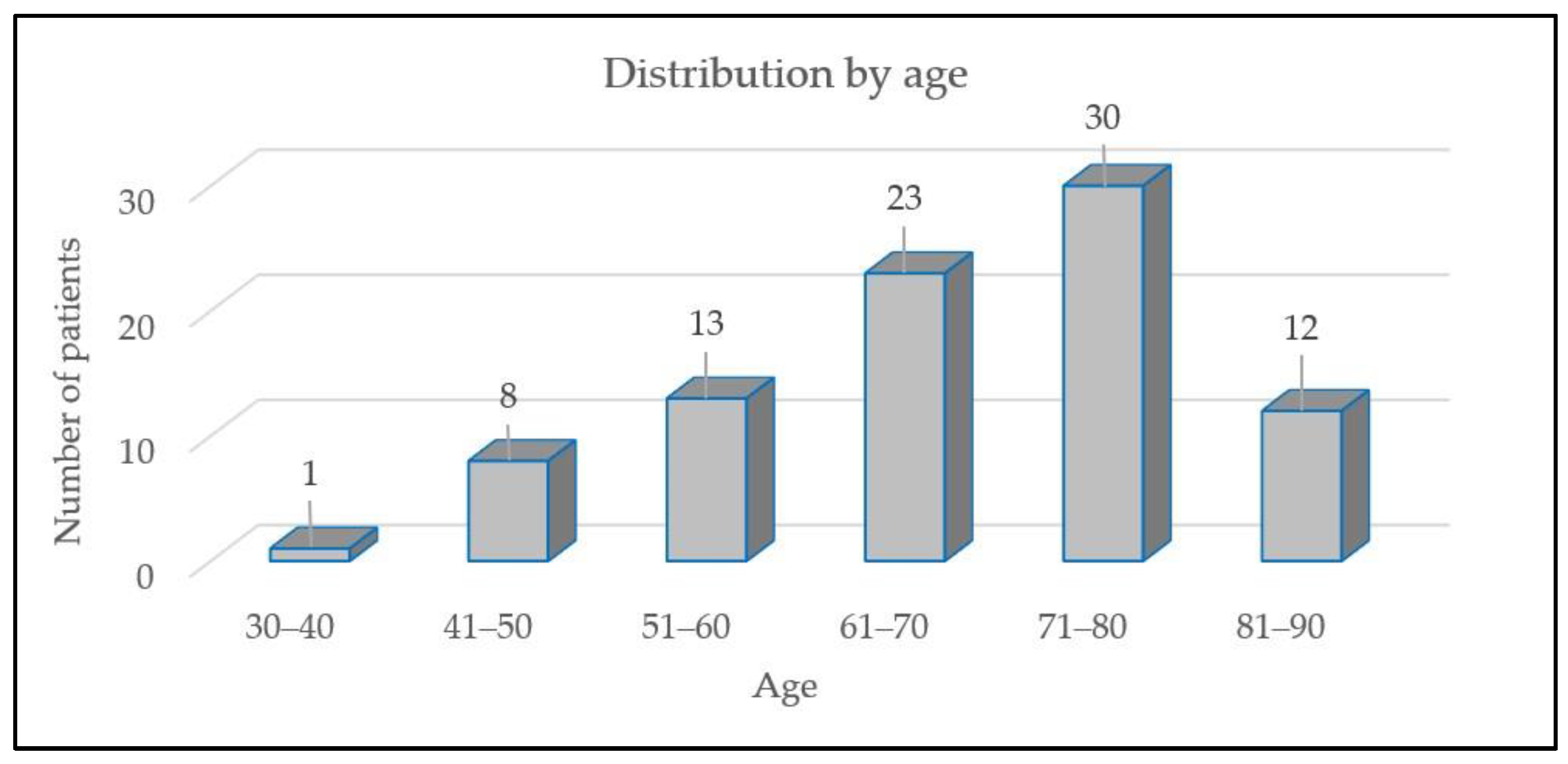
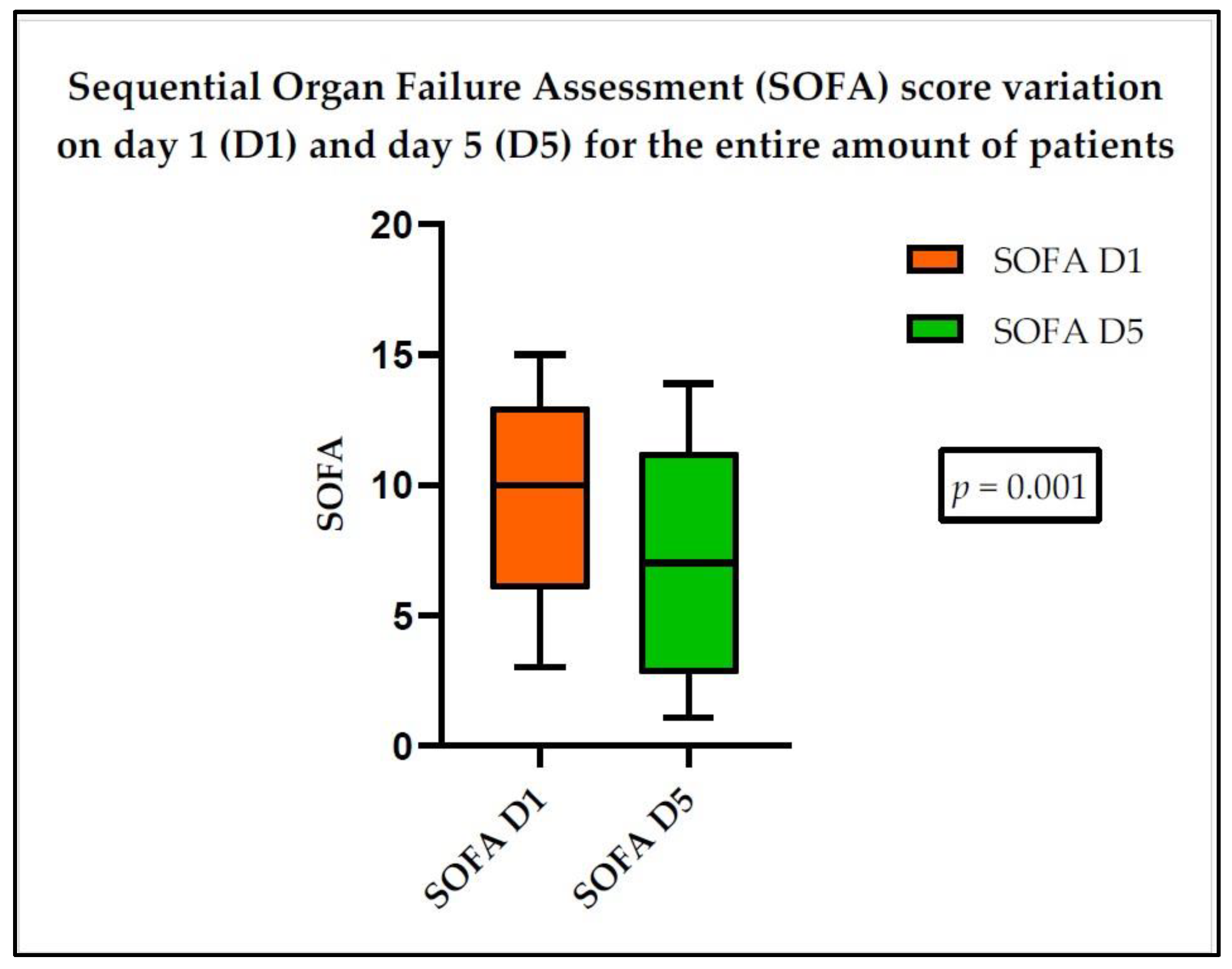


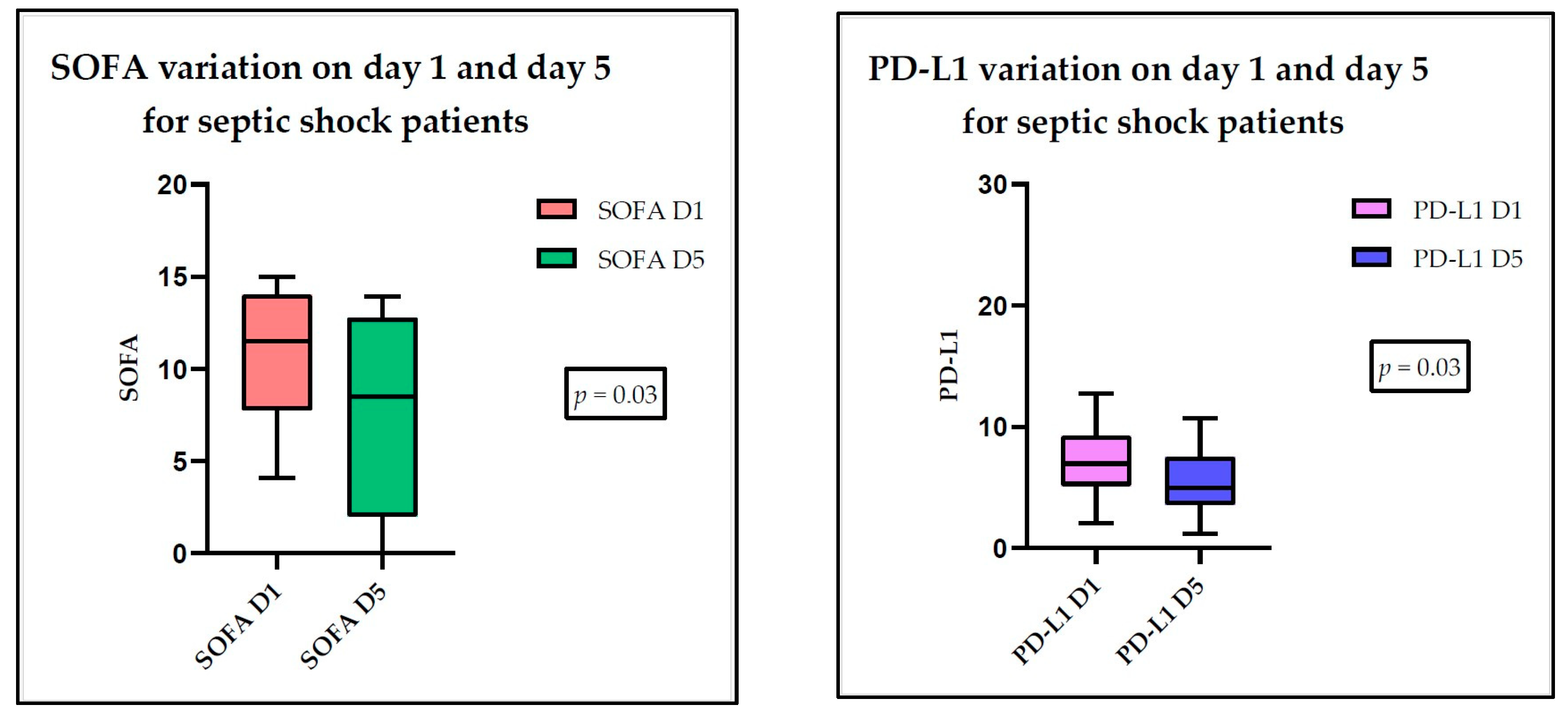
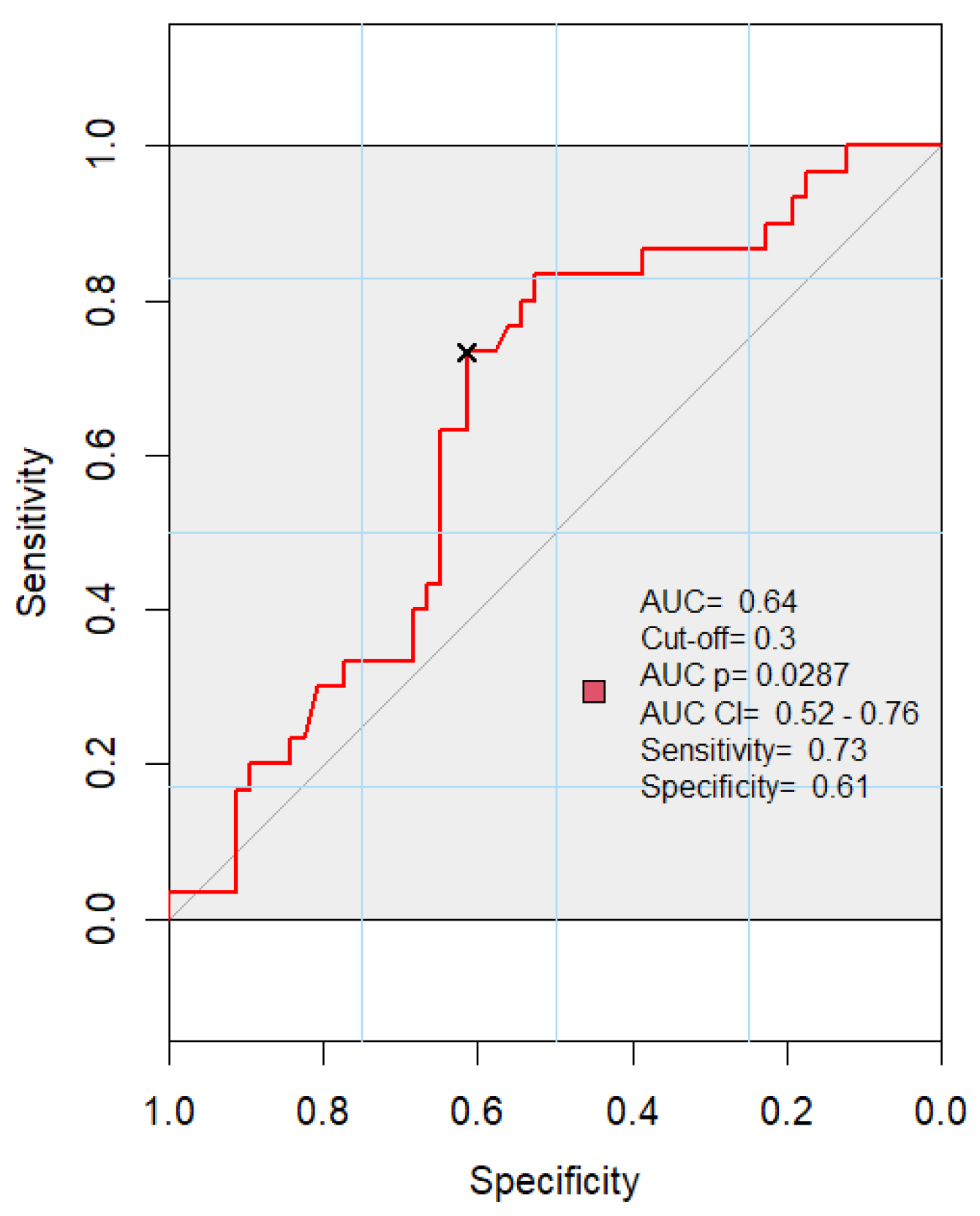
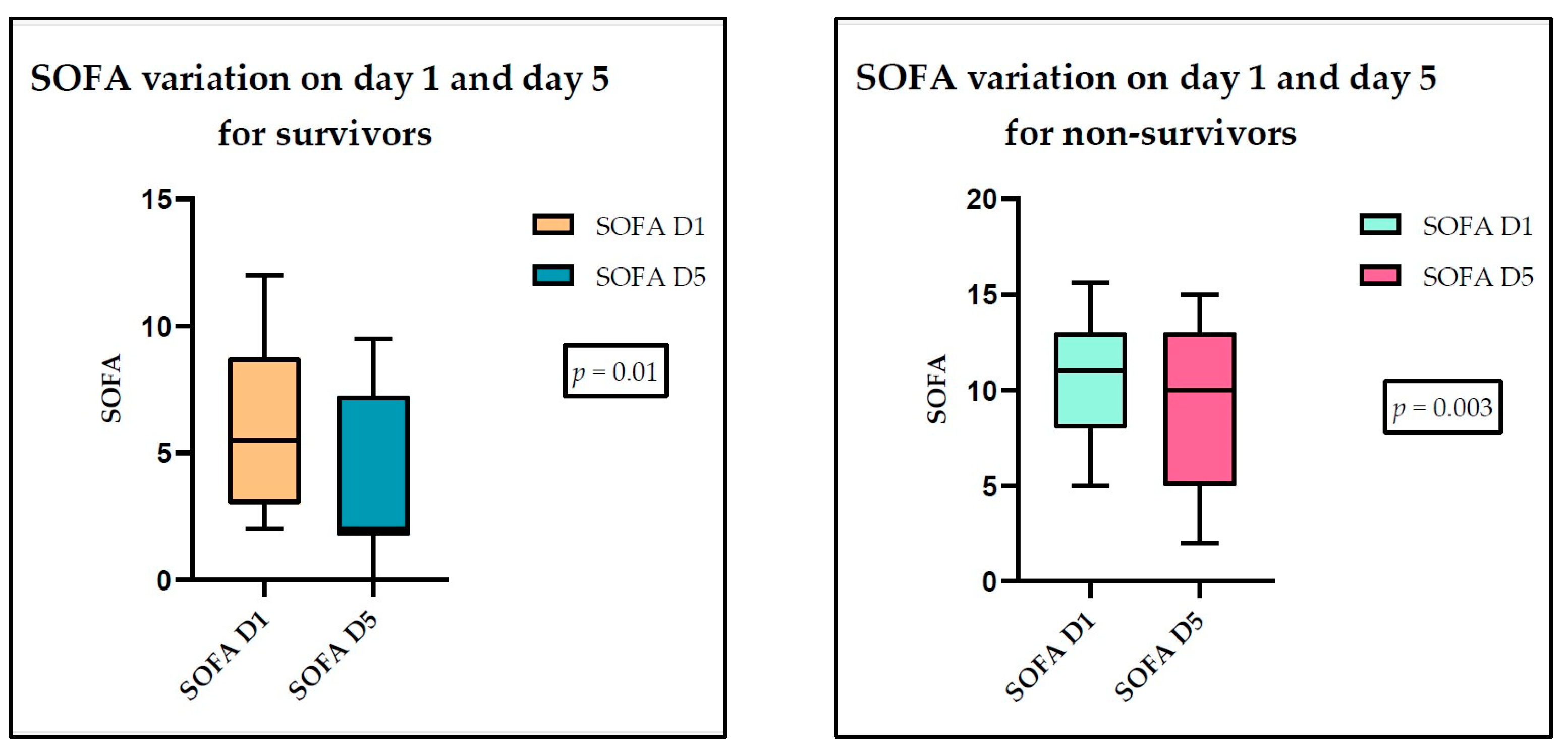
| Underlying Conditions | Number of Patients | % | Infectious Site | Number of Patients | % |
|---|---|---|---|---|---|
| Cardiovascular disease | 73 | 83.91 | Pulmonary | 51 | 58.6 |
| Renal disease | 58 | 69.88 | Abdominal | 30 | 34.5 |
| Respiratory disease | 55 | 63.22 | Urinary tract | 10 | 11.5 |
| Neurological disease | 42 | 48.28 | Cutaneous | 7 | 8.0 |
| Diabetes | 27 | 31.03 | Thoracic cavity | 1 | 1.1 |
| Trauma | 7 | 8.05 | Soft tissue | 1 | 1.1 |
| Other | 85 | 97.70 | Unidentified | 1 | 1.1 |
| Parameter (on Day 1) | PD-1 (ng/mL) | PD-L1 (ng/mL) |
|---|---|---|
| Th cells (CD4+) % | r = 0.1941 (−0.03038 to 0.4000) a p = 0.08 | r = 0.1378 (−0.09043 to 0.3523) p b = 0.24 |
| Tc cells (CD8+) % | r = −0.2545 (−0.4520 to −0.03317) a p = 0.02 | r =−0.2263 (−0.4353 to 0.005916) a p = 0.04 |
| Parameter (on day 5) | PD-1 (ng/mL) | PD-L1 (ng/mL) |
| Th cells (CD4+) % | r = −0.1661 (−0.4397 to 0.1357) a p =0.27 | r = −0.3306 (−0.5793 to −0.02552) p b = 0.03 |
| Tc cells (CD8+) % | r = 0.1366 (−0.1652 to 0.4150) a p = 0.36 | rho = 0.3982 (0.1032 to 0.6288) p b = 0.0099 |
| Parameter | Th cells (CD4+) % on day 1 | Th cells (CD4+) % on day 5 |
| Tc cells (CD8+) % | r = −0.7951 (−0.8631 to −0.6988) a p ≤ 0.0001 | r = −0.9558 (−0.9745 to −0.9238) p b ≤ 0.0001 |
| Parameter (on Day 1) | PD-1 (ng/mL) | PD-L1 (ng/mL) |
|---|---|---|
| SOFA | r = 0.08570 (−0.1402 to 0.3031) a p = 0.44 | r= 0.3511 (0.1365 to 0.5343) p b = 0.001 |
| APACHE II | r = 0.1346 (−0.09132 to 0.3474) a p = 0.2278 | r = 0.2822 (0.06065 to 0.4773) a p = 0.01 |
| Parameter (on day 5) | PD-1 (ng/mL) | PD-L1 (ng/mL) |
| SOFA | r = 0.06812 (−0.2350 to 0.3592) a p = 0.65 | r = 0.03967 (−0.2752 to 0.3469) p b = 0.80 |
| APACHE II | r = 0.1019 (−0.2026 to 0.3885) a p = 0.5 | rho = 0.1580 (−0.1615 to 0.4475) p b = 0.33 |
| Parameter | SOFA on day 1 | SOFA on day 5 |
| APACHE II | r = 0.7394 (0.6263 to 0.8220) p b ≤ 0.0001 | r = 0.7726 (0.6297 to 0.8649) p b ≤ 0.0001 |
| Tc Cells (CD8+) % | PD-1, ng/mL | PD-L1, ng/mL | SOFA | APACHE II | ||
|---|---|---|---|---|---|---|
| Th cells (CD4+) % | Day 1 | r = −0.8654 (−0.9188 to −0.7809) p b < 0.0001 | r = 0.1386 (−0.1449 to 0.4010) a p = 0.3224 | r = 0.1374 (−0.1496 to 0.4030) p b = 0.3466 | r = 0.08207 (−0.1824 to 0.3355) p b = 0.5439 | r = 0.09483 (−0.1699 to 0.3468) p b = 0.4829 |
| Day 5 | r = −0.9776 (−0.9887 to −0.9557) p b < 0.0001 | r = −0.2788 (−0.5881 to 0.1016) a p = 0.1357 | r = −0.001538 (−0.4068 to 0.4042) a p = 0.9942 | r = 0.01774 (−0.3330 to 0.3642) p b = 0.9232 | r = 0.01039 (−0.3395 to 0.3578) p b = 0.9550 | |
| Tc cells (CD8+) % | Day 1 | r = −0.1885 (−0.4431 to 0.09433) a p = 0.1765 | r = −0.2057 (−0.4603 to 0.08011) p b = 0.1562 | r = −0.1455 (−0.3913 to 0.1196) p b = 0.2801 | r = −0.1744 (−0.4161 to 0.09023) p b = 0.1944 | |
| Day 5 | r = 0.2487 (−0.1336 to 0.5665) a p = 0.1852 | r = 0.1078 (−0.3113 to 0.4918) a p = 0.6081 | r = −0.08839 (−0.4240 to 0.2686) p b = 0.6305 | r = −0.06552 (−0.4050 to 0.2898) p b = 0.7216 | ||
| PD-1, ng/mL | Day 1 | r = 0.002837 (−0.2958 to 0.3010) a p = 0.9851 | r = −0.004792 (−0.2823 to 0.2734) a p = 0.9728 | r = 0.2031 (−0.07920 to 0.4553) a p = 0.1446 | ||
| Day 5 | r = −0.06957 (−0.4700 to 0.3546) a p = 0.7467 | r = −0.04681 (−0.4096 to 0.3288) a p = 0.8060 | r = 0.05985 (−0.3171 to 0.4205) a p = 0.7534 | |||
| PD-L1, ng/mL | Day 1 | r = 0.2086 (−0.07714 to 0.4626) p b = 0.1504 | r = 0.2338 (−0.05075 to 0.4832) p b = 0.1059 | |||
| Day 5 | r = 0.003482 (−0.4026 to 0.4084) a p = 0.9868 | r = 0.2367 (−0.1868 to 0.5859) a p = 0.2547 | ||||
| SOFA | Day 1 | r = 0.7225 (0.5691 to 0.8273) p b < 0.0001 | ||||
| Day 5 | r = 0.7294 (0.5193 to 0.8563) p b < 0.0001 |
| Tc Cells (CD8+) % | PD-1, ng/mL | PD-L1, ng/mL | SOFA | APACHE II | ||
|---|---|---|---|---|---|---|
| Th cells (CD4+) % | Day 1 | r = −0.4830 (−0.7183 to −0.1486) p b = 0.0069 | r = 0.2340 (−0.1561 to 0.5609) a p = 0.2219 | r = 0.06571 (−0.3224 to 0.4349) p b = 0.7447 | r = 0.03528 (−0.3292 to 0.3906) p b = 0.8532 | r = 0.05343 (−0.3129 to 0.4059) p b = 0.7792 |
| Day 5 | r = −0.9042 (−0.9653 to −0.7491) p b < 0.0001 | r = −0.03431 (−0.5180 to 0.4660) a p = 0.8984 | r = −0.4075 (−0.7514 to 0.1105) p b = 0.1172 | r = 0.07724 (−0.4351 to 0.5518) p b = 0.7762 | r = 0.001199 (−0.4948 to 0.4966) p b = 0.9965 | |
| Tc cells (CD8+) % | Day 1 | r = −0.3345 (−0.6313 to 0.04784) a p = 0.0761 | r = −0.04149 (−0.4150 to 0.3439) p b = 0.8372 | r = −0.1220 (−0.4620 to 0.2492) p b = 0.5206 | r = 0.01866 (−0.3439 to 0.3764) p b = 0.9220 | |
| Day 5 | r = −0.02696 (−0.5126 to 0.4718) a p = 0.9209 | r = 0.4329 (−0.08000 to 0.7645) p b = 0.0940 | r = −0.09829 (−0.5664 to 0.4178) p b = 0.7173 | r = −0.03894 (−0.5245 to 0.4658) p b = 0.8861 | ||
| PD-1, ng/mL | Day 1 | r = 0.4566 (0.07218 to 0.7230) a p = 0.0190 | r = 0.1846 (−0.2060 to 0.5244) a p = 0.3378 | r = 0.06407 (−0.3199 to 0.4300) a p = 0.7413 | ||
| Day 5 | r = 0.3088 (−0.2359 to 0.7059) a p = 0.2440 | r = 0.3333 (−0.2099 to 0.7193) a p = 0.2058 | r = 0.1372 (−0.3983 to 0.6029) a p = 0.6101 | |||
| PD-L1, ng/mL | Day 1 | r = 0.4909 (0.1363 to 0.7340) p b = 0.0093 | r = 0.3373 (−0.04903 to 0.6358) p b = 0.0854 | |||
| Day 5 | r = 0.1272 (−0.4119 to 0.6003) p b = 0.6515 | r = 0.1370 (−0.4036 to 0.6067) p b = 0.6263 | ||||
| SOFA | Day 1 | r = 0.8070 (0.6298 to 0.9043) p b < 0.0001 | ||||
| Day 5 | r = 0.8433 (0.5972 to 0.9443) p b < 0.0001 |
| Tc Cells (CD8+) % | PD-1, ng/mL | PD-L1, ng/mL | SOFA | APACHE II | ||
|---|---|---|---|---|---|---|
| Th cells (CD4+) % | Day 1 | r = −0.9368 (−0.9726 to −0.8575) p b < 0.0001 | r = −0.2344 (−0.5910 to 0.1988) a p = 0.2703 | r = 0.1030 (−0.3679 to 0.5319) a p = 0.6655 | r = 0.07439 (−0.3392 to 0.4639) p b = 0.7298 | r = −0.09935 (−0.4834 to 0.3167) p b = 0.6442 |
| Day 5 | r = −0.9788 (−0.9922 to −0.9426) p b < 0.0001 | r = 0.05296 (−0.4547 to 0.5346) p b = 0.8456 | r = −0.06786 (−0.5720 to 0.4735) a p = 0.8124 | r = −0.1823 (−0.6600 to 0.4004) a p = 0.5303 | r = −0.2830 (−0.7074 to 0.2913) p b = 0.3268 | |
| Tc cells (CD8+) % | Day 1 | r = 0.1723 (−0.2602 to 0.5472) a p = 0.4207 | r = −0.07446 (−0.5110 to 0.3926) a p = 0.7550 | r = −0.1931 (−0.5534 to 0.2280) p b = 0.3659 | r = 0.008656 (−0.3961 to 0.4106) p b = 0.9680 | |
| Day 5 | r = −0.01212 (−0.5048 to 0.4865) p b = 0.9645 | r = 0.1893 (−0.3722 to 0.6493) a p = 0.4983 | r = 0.1170 (−0.4549 to 0.6206) a p = 0.6894 | r = 0.3229 (−0.2506 to 0.7286) p b = 0.2602 | ||
| PD-1, ng/mL | Day 1 | r = −0.1835 (−0.5882 to 0.2948) a p = 0.4388 | r = 0.02186 (−0.3957 to 0.4319) a p = 0.9193 | r = −0.1161 (−0.5057 to 0.3129) a p = 0.5892 | ||
| Day 5 | r = 0.05934 (−0.4998 to 0.5836) a p = 0.8438 | r = 0.2519 (−0.3633 to 0.7141) a p = 0.4044 | r = 0.006637 (−0.5463 to 0.5556) p b = 0.9828 | |||
| PD-L1, ng/mL | Day 1 | r = −0.05898 (−0.4994 to 0.4056) a p = 0.8049 | r = −0.07472 (−0.5111 to 0.3923) a p = 0.7542 | |||
| Day 5 | r = −0.1015 (−0.6495 to 0.5159) a p = 0.7583 | r = −0.2050 (−0.7067 to 0.4339) a p = 0.5201 | ||||
| SOFA | Day 1 | r = 0.7352 (0.4718 to 0.8782) p b < 0.0001 | ||||
| Day 5 | r = 0.8397 (0.5452 to 0.9497) p b = 0.0003 |
| Tc Cells (CD8+) % | PD-1, ng/mL | PD-L1, ng/mL | SOFA | APACHE II | ||
|---|---|---|---|---|---|---|
| Th cells (CD4+) % | Day 1 | r = −0.7114 (−0.8155 to −0.5629) p b < 0.0001 | r = 0.3463 (0.08886 to 0.5603) a p = 0.0078 | r = 0.1843 (−0.08264 to 0.4265) p b = 0.1740 | r = 0.1454 (−0.1062 to 0.3795) p b = 0.2556 | r = 0.1835 (−0.06737 to 0.4125) p b = 0.1501 |
| Day 5 | r = −0.9461 (−0.9730 to −0.8939) p b < 0.0001 | r = −0.4123 (−0.6749 to −0.05702) a p = 0.0212 | r = −0.2116 (−0.5536 to 0.1915) p b = 0.2995 | r = 0.02640 (−0.3146 to 0.3613) p b = 0.8822 | r = 0.01088 (−0.3285 to 0.3478) p b = 0.9513 | |
| Tc cells (CD8+) % | Day 1 | r = −0.3873 (−0.5920 to −0.1357) a p = 0.0027 | r = −0.2790 (−0.5049 to −0.01736) p b = 0.0373 | r = −0.2283 (−0.4506 to 0.02059) p b = 0.0719 | r = −0.1836 (−0.4126 to 0.06722) p b = 0.1498 | |
| Day 5 | r = 0.3414 (−0.02566 to 0.6273) a p = 0.0602 | r = 0.2440 (−0.1584 to 0.5768) p b = 0.2297 | r = −0.1121 (−0.4338 to 0.2350) p b = 0.5280 | r = −0.1009 (−0.4246 to 0.2457) p b = 0.5703 | ||
| PD-1, ng/mL | Day 1 | r = 0.2528 (−0.02984 to 0.4980) a p = 0.0706 | r = 0.1357 (−0.1347 to 0.3873) a p = 0.3097 | r= 0.2432 (−0.02392 to 0.4779) a p = 0.0658 | ||
| Day 5 | r = 0.03316 (−0.3693 to 0.4251) a p = 0.8722 | r = 0.05831 (−0.3005 to 0.4026) a p = 0.7472 | r = 0.1770 (−0.1872 to 0.4985) a p = 0.3243 | |||
| PD-L1, ng/mL | Day 1 | r = 0.4850 (0.2545 to 0.6633) p b = 0.0002 | r = 0.3710 (0.1198 to 0.5776) p b = 0.0049 | |||
| Day 5 | r = −0.004608 (−0.3770 to 0.3691) p b = 0.9814 | r = 0.1172 (−0.2676 to 0.4697) p b = 0.5526 | ||||
| SOFA | Day 1 | r = 0.6471 (0.4756 to 0.7712) p b < 0.0001 | ||||
| Day 5 | r = 0.6939 (0.4733 to 0.8326) p b < 0.0001 |
Disclaimer/Publisher’s Note: The statements, opinions and data contained in all publications are solely those of the individual author(s) and contributor(s) and not of MDPI and/or the editor(s). MDPI and/or the editor(s) disclaim responsibility for any injury to people or property resulting from any ideas, methods, instructions or products referred to in the content. |
© 2024 by the authors. Licensee MDPI, Basel, Switzerland. This article is an open access article distributed under the terms and conditions of the Creative Commons Attribution (CC BY) license (https://creativecommons.org/licenses/by/4.0/).
Share and Cite
Coman, O.; Grigorescu, B.-L.; Huțanu, A.; Bacârea, A.; Văsieșiu, A.M.; Fodor, R.Ș.; Stoica, F.; Azamfirei, L. The Role of Programmed Cell Death 1/Programmed Death Ligand 1 (PD-1/PD-L1) Axis in Sepsis-Induced Apoptosis. Medicina 2024, 60, 1174. https://doi.org/10.3390/medicina60071174
Coman O, Grigorescu B-L, Huțanu A, Bacârea A, Văsieșiu AM, Fodor RȘ, Stoica F, Azamfirei L. The Role of Programmed Cell Death 1/Programmed Death Ligand 1 (PD-1/PD-L1) Axis in Sepsis-Induced Apoptosis. Medicina. 2024; 60(7):1174. https://doi.org/10.3390/medicina60071174
Chicago/Turabian StyleComan, Oana, Bianca-Liana Grigorescu, Adina Huțanu, Anca Bacârea, Anca Meda Văsieșiu, Raluca Ștefania Fodor, Florin Stoica, and Leonard Azamfirei. 2024. "The Role of Programmed Cell Death 1/Programmed Death Ligand 1 (PD-1/PD-L1) Axis in Sepsis-Induced Apoptosis" Medicina 60, no. 7: 1174. https://doi.org/10.3390/medicina60071174
APA StyleComan, O., Grigorescu, B.-L., Huțanu, A., Bacârea, A., Văsieșiu, A. M., Fodor, R. Ș., Stoica, F., & Azamfirei, L. (2024). The Role of Programmed Cell Death 1/Programmed Death Ligand 1 (PD-1/PD-L1) Axis in Sepsis-Induced Apoptosis. Medicina, 60(7), 1174. https://doi.org/10.3390/medicina60071174








